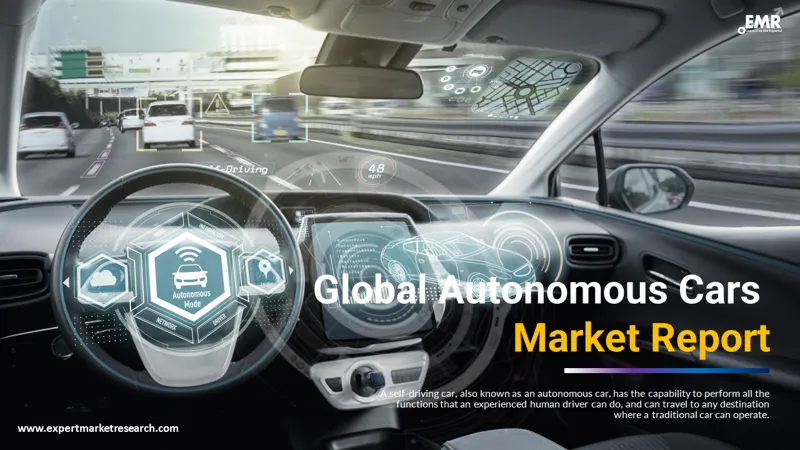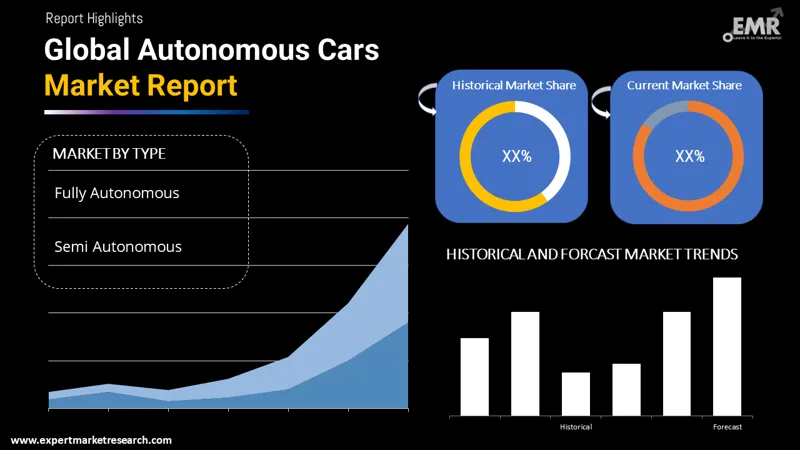
Consumer Insights
Uncover trends and behaviors shaping consumer choices today
Procurement Insights
Optimize your sourcing strategy with key market data
Industry Stats
Stay ahead with the latest trends and market analysis.
The global autonomous cars market attained a value of nearly USD 48.71 Billion in 2025. The market is further estimated to grow in the forecast period of 2026-2035 at a CAGR of 20.60% to reach a value of USD 317.02 Billion by 2035.
Base Year
Historical Period
Forecast Period
Compound Annual Growth Rate
20.6%
Value in USD Billion
2026-2035
*this image is indicative*
| Global Autonomous Cars Market Report Summary | Description | Value |
| Base Year | USD Billion | 2025 |
| Historical Period | USD Billion | 2019-2025 |
| Forecast Period | USD Billion | 2026-2035 |
| Market Size 2025 | USD Billion | 48.71 |
| Market Size 2035 | USD Billion | 317.02 |
| CAGR 2019-2025 | Percentage | XX% |
| CAGR 2026-2035 | Percentage | 20.60% |
| CAGR 2026-2035 - Market by Region | Asia Pacific | 23.7% |
| CAGR 2026-2035 - Market by Country | China | 22.7% |
| CAGR 2026-2035 - Market by Country | India | 19.8% |
| CAGR 2026-2035 - Market by Type | Fully Autonomous | 23.1% |
| Market Share by Country 2025 | Germany | 4.5% |
Asia Pacific holds a significant share in the autonomous cars market on account of the surging R&D activities across the region. The increased adoption of vehicles and rising investment by automakers along with technological advancements are further bolstering the market growth of autonomous cars across the region. There are a high number of road accidents due to the growing population and rising demand for better safety features in the vehicles. These factors are likely to fuel the market growth of autonomous cars is in the Asia Pacific during the forecast period.

Read more about this report - REQUEST FREE SAMPLE COPY IN PDF
There is also a high presence of tech companies in the Asia Pacific region like Softbank, Baidu, Alibaba, and Didi Chuxing. A strong market presence, growing marketing strategies, and surging focus to enhance the adoption of autonomous vehicles among consumers, are expected to propel the market growth. Countries like Singapore, Japan, and China have registered robust market growth in autonomous cars in the Asia Pacific. Their growth can be attributed to aspects like technology readiness, public acceptance, and regulatory matters in the automotive industry.
An autonomous car is known as a self-driving car. Such a car can do everything that an experienced human driver does and can go anywhere a traditional car can go. It is a vehicle capable of sensing its environment and operating without human participation. A human passenger is not needed to be present in the vehicle at all, nor is needed to take control of the vehicle at any time.
The autonomous cars market, by type, is divided into:
Market Breakup by Region:

Read more about this report - REQUEST FREE SAMPLE COPY IN PDF
Based on type, the semi-autonomous segment is likely to register significant growth in the autonomous cars market across the globe during the forecast period. Semi-autonomous vehicles are likely to be more fuel-efficient as compared to others. They can decelerate and accelerate more efficiently than a human driver while the travel time and idling time are expected to be lessened.
The semi-autonomous segment is likely to reduce congestion and enhance highway capacity as the system safely accommodates shorter following distances, further boosting the market demand for autonomous cars globally. Moreover, semi-autonomous vehicles deliver goods and services more efficiently and quickly which is further attracting more consumers to the worldwide market of autonomous cars.
| CAGR 2026-2035 - Market by | Country |
| China | 22.7% |
| India | 19.8% |
| USA | 18.4% |
| France | 16.1% |
| Italy | 14.4% |
| Canada | XX% |
| UK | XX% |
| Germany | XX% |
| Japan | 14.2% |
| Australia | XX% |
| Saudi Arabia | XX% |
| Brazil | XX% |
| Mexico | XX% |
The report presents a detailed analysis of the following key players in the global autonomous cars market, looking into their capacity, market shares, and latest developments like capacity expansions, plant turnarounds, and mergers and acquisitions:
The comprehensive report looks into the macro and micro aspects of the market. The EMR report gives an in-depth insight into the market by providing a SWOT analysis as well as an analysis of Porter’s Five Forces model.




*While we strive to always give you current and accurate information, the numbers depicted on the website are indicative and may differ from the actual numbers in the main report. At Expert Market Research, we aim to bring you the latest insights and trends in the market. Using our analyses and forecasts, stakeholders can understand the market dynamics, navigate challenges, and capitalize on opportunities to make data-driven strategic decisions.*
Get in touch with us for a customized solution tailored to your unique requirements and save upto 35%!
In 2025, the market size at a global level attained a value of nearly USD 48.71 Billion.
The market is assessed to grow at a CAGR of 20.60% between 2026 and 2035.
The market is estimated to witness healthy growth in the forecast period of 2026-2035 to reach a value of almost USD 317.02 Billion by 2035.
The major market drivers are increasing importance of safety, growing urbanisation, and a decline in traffic congestion.
The key market trends include technological advancements along with rapid adoption of the Internet of Things (IoT), and growing investments in digital infrastructure.
The major regions in the market are North America, Europe, Asia Pacific, Latin America, and the Middle East and Africa.
The various types of autonomous cars in the market currently are fully autonomous and semi-autonomous types.
The major players in the market are Tesla, Inc., Toyota Motor Corporation, Audi AG, and Mercedes-Benz AG, among others.
Explore our key highlights of the report and gain a concise overview of key findings, trends, and actionable insights that will empower your strategic decisions.
| REPORT FEATURES | DETAILS |
| Base Year | 2025 |
| Historical Period | 2019-2025 |
| Forecast Period | 2026-2035 |
| Scope of the Report |
Historical and Forecast Trends, Industry Drivers and Constraints, Historical and Forecast Market Analysis by Segment:
|
| Breakup by Type |
|
| Breakup by Region |
|
| Market Dynamics |
|
| Competitive Landscape |
|
| Companies Covered |
|
Datasheet
One User
USD 2,499
USD 2,249
tax inclusive*
Single User License
One User
USD 3,999
USD 3,599
tax inclusive*
Five User License
Five User
USD 4,999
USD 4,249
tax inclusive*
Corporate License
Unlimited Users
USD 5,999
USD 5,099
tax inclusive*
*Please note that the prices mentioned below are starting prices for each bundle type. Kindly contact our team for further details.*
Flash Bundle
Small Business Bundle
Growth Bundle
Enterprise Bundle
*Please note that the prices mentioned below are starting prices for each bundle type. Kindly contact our team for further details.*
Flash Bundle
Number of Reports: 3
20%
tax inclusive*
Small Business Bundle
Number of Reports: 5
25%
tax inclusive*
Growth Bundle
Number of Reports: 8
30%
tax inclusive*
Enterprise Bundle
Number of Reports: 10
35%
tax inclusive*
How To Order

Select License Type
Choose the right license for your needs and access rights.

Click on ‘Buy Now’
Add the report to your cart with one click and proceed to register.

Select Mode of Payment
Choose a payment option for a secure checkout. You will be redirected accordingly.
Gain insights to stay ahead and seize opportunities.

Get insights & trends for a competitive edge.

Track prices with detailed trend reports.

Analyse trade data for supply chain insights.

Leverage cost reports for smart savings

Enhance supply chain with partnerships.

Connect For More Information
Our expert team of analysts will offer full support and resolve any queries regarding the report, before and after the purchase.
Our expert team of analysts will offer full support and resolve any queries regarding the report, before and after the purchase.
We employ meticulous research methods, blending advanced analytics and expert insights to deliver accurate, actionable industry intelligence, staying ahead of competitors.
Our skilled analysts offer unparalleled competitive advantage with detailed insights on current and emerging markets, ensuring your strategic edge.
We offer an in-depth yet simplified presentation of industry insights and analysis to meet your specific requirements effectively.
Share